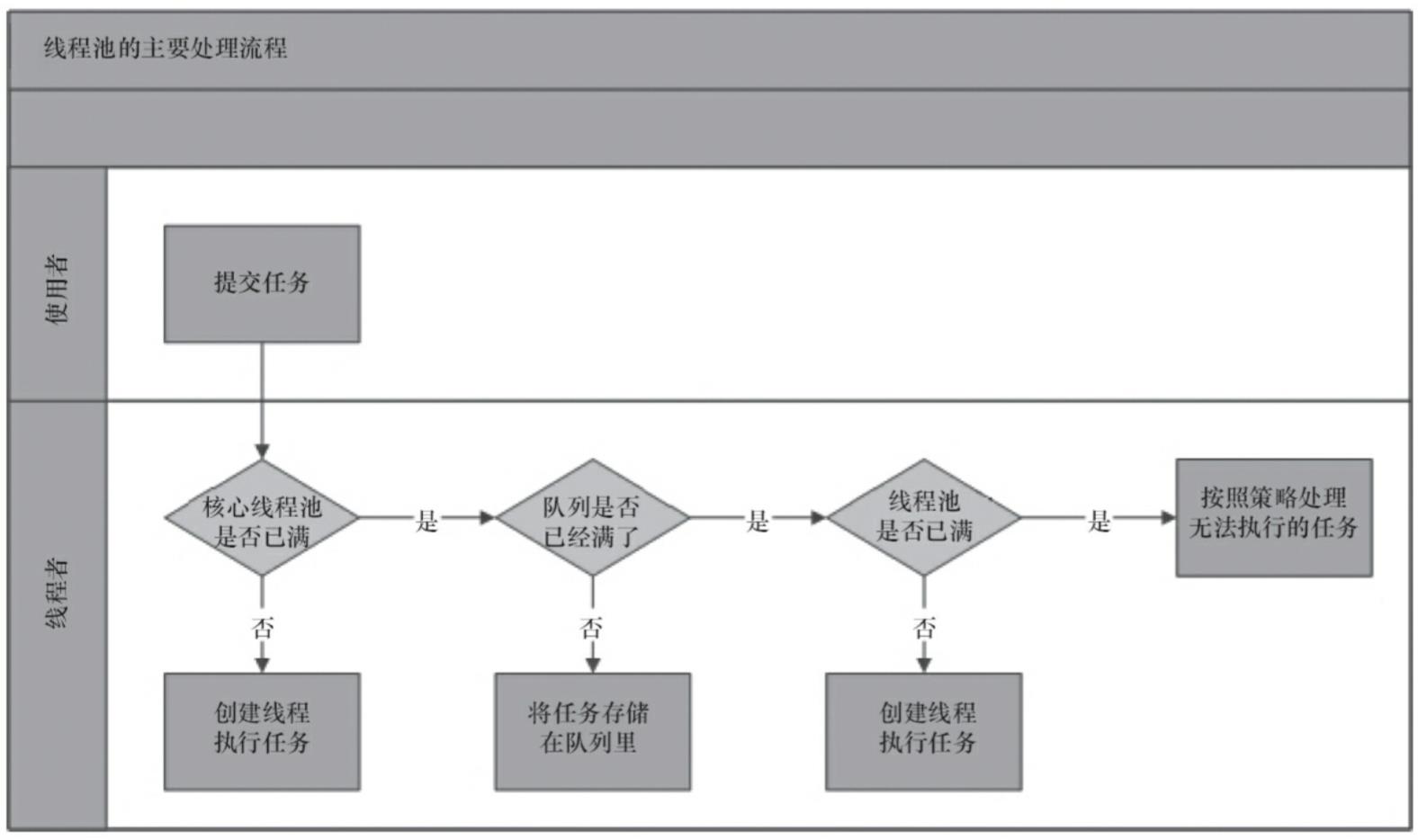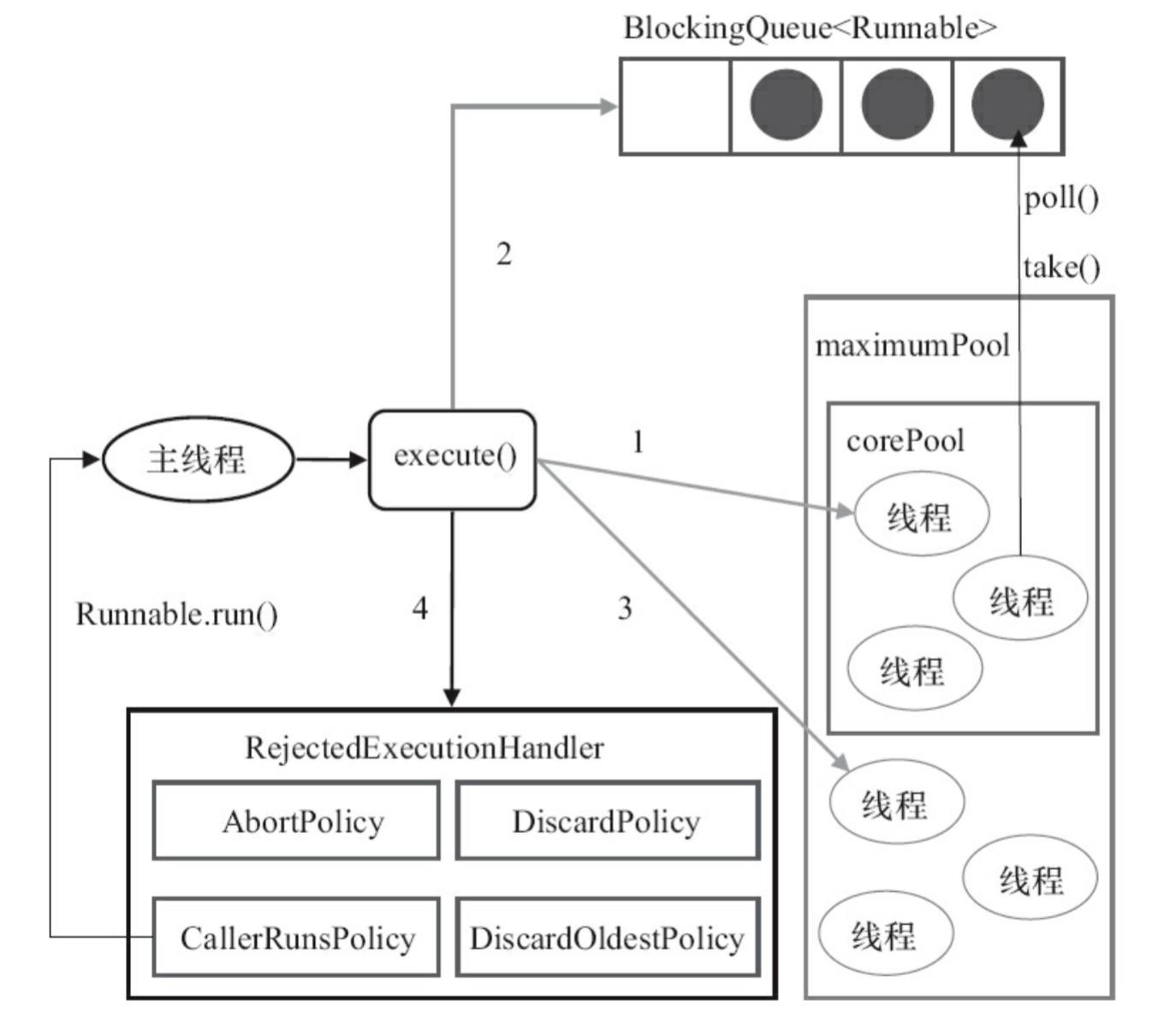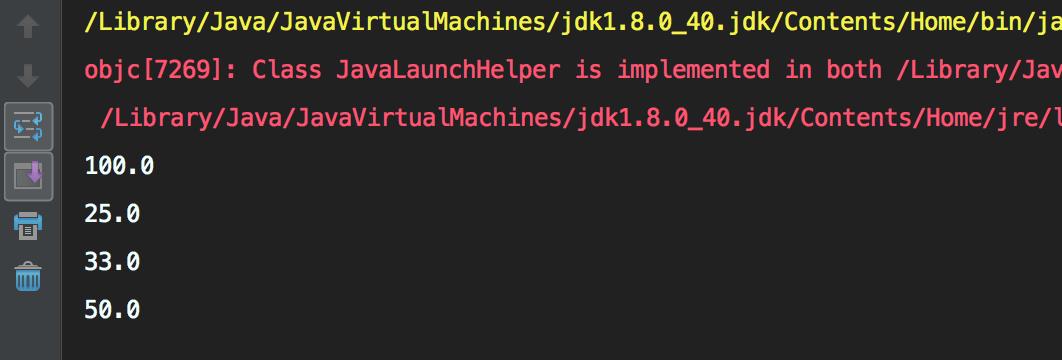java笔记java中的线程池ThreadPoolExecutor的原理和使用
Posted 棉花糖灬
tags:
篇首语:本文由小常识网(cha138.com)小编为大家整理,主要介绍了java笔记java中的线程池ThreadPoolExecutor的原理和使用相关的知识,希望对你有一定的参考价值。
本文摘自简书作者“juconcurrent”的文章java线程池的使用。
线程池顾名思义就是存放线程的池子,本质是一种对象池,用来管理线程资源。线程池的使用避免了每次使用线程时重复的创建线程,而是从线程池中取出一个线程来执行任务,执行完再把线程放回线程池。
一、线程池的实现原理
1. 线程池的处理流程 
- 判断核心线程池是否已满,如果不是,则创建线程执行任务
- 如果核心线程池满了,判断队列是否满了,如果队列没满,将任务放在队列中
- 如果队列满了,则判断线程池是否已满,如果没满,创建线程执行任务
- 如果线程池也满了,则按照拒绝策略对任务进行处理
2. java中ThreadPoolExecutor的处理流程

其中:
corePool:核心线程池maximumPool:线程池BlockQueue:队列RejectedExecutionHandler:拒绝策略
3. 入门实例
package ecnu.cn;
import java.util.concurrent.ExecutorService;
import java.util.concurrent.Executors;
public class ThreadPoolTest {
public static void main(String[] args) {
// 创建大小固定为5的线程池
ExecutorService executor = Executors.newFixedThreadPool(5);
for (int i = 0; i < 10; i++) {
executor.submit(() -> {
System.out.println("thread id is: " + Thread.currentThread().getId());
try {
Thread.sleep(1000);
} catch (InterruptedException e) {
e.printStackTrace();
}
});
}
}
}
输出:
thread id is: 12
thread id is: 16
thread id is: 15
thread id is: 13
thread id is: 14
thread id is: 15
thread id is: 12
thread id is: 16
thread id is: 14
thread id is: 13
二、Executor线程工厂
Executor是一个线程工厂,用它可以创建如下的线程池:
// 创建单一线程的线程池
public static ExecutorService newSingleThreadExecutor();
// 创建固定数量的线程池
public static ExecutorService newFixedThreadPool(int nThreads);
// 创建带缓存的线程池
public static ExecutorService newCachedThreadPool();
// 创建定时调度的线程池
public static ScheduledExecutorService newScheduledThreadPool(int corePoolSize);
// 创建流式(fork-join)线程池
public static ExecutorService newWorkStealingPool();
1. 创建单一线程的线程池
顾名思义,这个线程池只有一个线程。若多个任务被提交到此线程池,那么会被缓存到队列(队列长度为Integer.MAX_VALUE)。当线程空闲的时候,按照FIFO的方式进行处理。
2. 创建固定数量的线程池
和创建单一线程的线程池类似,只是这儿可以并行处理任务的线程数更多一些罢了。若多个任务被提交到此线程池,会有下面的处理过程。
-
如果线程的数量未达到指定数量,则创建线程来执行任务
-
如果线程池的数量达到了指定数量,并且有线程是空闲的,则取出空闲线程执行任务
-
如果没有线程是空闲的,则将任务缓存到队列(队列长度为
Integer.MAX_VALUE)。当线程空闲的时候,按照FIFO的方式进行处理
3. 创建带缓存的线程池
这种方式创建的线程池,核心线程池的长度为0,线程池最大长度为Integer.MAX_VALUE。由于本身使用SynchronousQueue作为等待队列的缘故,导致往队列里面每插入一个元素,必须等待另一个线程从这个队列删除一个元素。
4. 创建定时调度的线程池
和上面3个工厂方法返回的线程池类型有所不同,它返回的是ScheduledThreadPoolExecutor类型的线程池。
例子:
package ecnu.cn;
import java.util.concurrent.ExecutorService;
import java.util.concurrent.Executors;
import java.util.concurrent.ScheduledExecutorService;
import java.util.concurrent.TimeUnit;
public class ThreadPoolTest {
public static void main(String[] args) {
ScheduledExecutorService executor = Executors.newScheduledThreadPool(2);
// 定时调度,每个调度任务会至少等待`period`的时间,
// 如果任务执行的时间超过`period`,则等待的时间为任务执行的时间
executor.scheduleAtFixedRate(() -> {
try {
Thread.sleep(10000);
System.out.println(System.currentTimeMillis() / 1000);
} catch (InterruptedException e) {
e.printStackTrace();
}
}, 0, 2, TimeUnit.SECONDS);
// 定时调度,第二个任务执行的时间 = 第一个任务执行时间 + `delay`
executor.scheduleWithFixedDelay(() -> {
try {
Thread.sleep(5000);
System.out.println(System.currentTimeMillis() / 1000);
} catch (InterruptedException e) {
e.printStackTrace();
}
}, 0, 2, TimeUnit.SECONDS);
// 定时调度,延迟`delay`后执行,且只执行一次
executor.schedule(() -> System.out.println("5 秒之后执行 schedule"), 5, TimeUnit.SECONDS);
}
}
其输出为:
1624324729
5 秒之后执行 schedule
1624324734
1624324736
1624324743
1624324744
1624324750
1624324754
1624324757
1624324764
1624324764
...
scheduleAtFixedRate(Runnable command, long initialDelay, long period, TimeUnit unit),定时调度,每个调度任务会至少等待period的时间,如果任务执行的时间超过period,则等待的时间为任务执行的时间scheduleWithFixedDelay(Runnable command, long initialDelay, long delay, TimeUnit unit),定时调度,第二个任务执行的时间 = 第一个任务执行时间 +delayschedule(Runnable command, long delay, TimeUnit unit),定时调度,延迟delay后执行,且只执行一次
三、手动创建线程池
理论上,我们可以通过Executors来创建线程池,这种方式非常简单。但正是因为简单,所以限制了线程池的功能。比如:无长度限制的队列,可能因为任务堆积导致OOM,怎么避免?归根结底,还是需要我们通过更底层的方式来创建线程池。
ThreadPoolExecutor最底层的构造方法如下:
public ThreadPoolExecutor(int corePoolSize,
int maximumPoolSize,
long keepAliveTime,
TimeUnit unit,
BlockingQueue<Runnable> workQueue,
ThreadFactory threadFactory,
RejectedExecutionHandler handler);
其参数:
corePoolSize:线程池中的核心线程数maximumPoolSize:线程池中的最大线程数keepAliveTime:空闲时间,当线程池数量超过核心线程数时,多余的空闲线程存活的时间,即:这些线程多久被销毁。unit:空闲时间的单位,可以是毫秒、秒、分钟、小时和天,等等workQueue:等待队列,线程池中的线程数超过核心线程数时,任务将放在等待队列,它是一个BlockingQueue类型的对象threadFactory:线程工厂,我们可以使用它来创建一个线程handler:拒绝策略,当线程池和等待队列都满了之后,需要通过该对象的回调函数进行回调处理
这些参数里面,基本类型的参数都比较简单,我们不做进一步的分析。我们更关心的是workQueue、threadFactory和handler,接下来我们将进一步分析。
1. 等待队列workQueue
等待队列是BlockingQueue类型的,理论上只要是它的子类,我们都可以用来作为等待队列。
同时,jdk内部自带一些阻塞队列,主要有:
ArrayBlockingQueue,队列是有界的,基于数组实现的阻塞队列LinkedBlockingQueue,队列可以有界,也可以无界。基于链表实现的阻塞队列SynchronousQueue,不存储元素的阻塞队列,每个插入操作必须等到另一个线程调用移除操作,否则插入操作将一直处于阻塞状态。该队列也是Executors.newCachedThreadPool()的默认队列PriorityBlockingQueue,带优先级的无界阻塞队列
通常情况下,我们需要指定阻塞队列的上界(比如1024)。另外,如果执行的任务很多,我们可能需要将任务进行分类,然后将不同分类的任务放到不同的线程池中执行。
2. 线程工厂threadFactory
ThreadFactory是一个接口,只有一个方法。既然是线程工厂,那么我们就可以用它生产一个线程对象。来看看这个接口的定义。
public interface ThreadFactory {
/**
* Constructs a new {@code Thread}. Implementations may also initialize
* priority, name, daemon status, {@code ThreadGroup}, etc.
*
* @param r a runnable to be executed by new thread instance
* @return constructed thread, or {@code null} if the request to
* create a thread is rejected
*/
Thread newThread(Runnable r);
}
Executors的实现使用了默认的线程工厂-DefaultThreadFactory。它的实现主要用于创建一个线程,线程的名字为pool-{poolNum}-thread-{threadNum}。
static class DefaultThreadFactory implements ThreadFactory {
private static final AtomicInteger poolNumber = new AtomicInteger(1);
private final ThreadGroup group;
private final AtomicInteger threadNumber = new AtomicInteger(1);
private final String namePrefix;
DefaultThreadFactory() {
SecurityManager s = System.getSecurityManager();
group = (s != null) ? s.getThreadGroup() :
Thread.currentThread().getThreadGroup();
namePrefix = "pool-" +
poolNumber.getAndIncrement() +
"-thread-";
}
public Thread newThread(Runnable r) {
Thread t = new Thread(group, r,
namePrefix + threadNumber.getAndIncrement(),
0);
if (t.isDaemon())
t.setDaemon(false);
if (t.getPriority() != Thread.NORM_PRIORITY)
t.setPriority(Thread.NORM_PRIORITY);
return t;
}
}
很多时候,我们需要自定义线程名字。我们只需要自己实现ThreadFactory,用于创建特定场景的线程即可。
3. 拒绝策略handler
所谓拒绝策略,就是当线程池满了、队列也满了的时候,我们对任务采取的措施。或者丢弃、或者执行、或者其他…
jdk自带4种拒绝策略:
CallerRunsPolicy// 在调用者线程执行AbortPolicy// 直接抛出RejectedExecutionException异常DiscardPolicy// 任务直接丢弃,不做任何处理DiscardOldestPolicy// 丢弃队列里最旧的那个任务,再尝试执行当前任务
这四种策略各有优劣,比较常用的是DiscardPolicy,但是这种策略有一个弊端就是任务执行的轨迹不会被记录下来。所以,我们往往需要实现自定义的拒绝策略, 通过实现RejectedExecutionHandler接口的方式。
4. 提交任务的几种方式
往线程池中提交任务,主要有两种方法,execute()和submit()。
execute()用于提交不需要返回结果的任务,我们看一个例子。
public static void main(String[] args) {
ExecutorService executor = Executors.newFixedThreadPool(2);
executor.execute(() -> System.out.println("hello"));
}
submit()用于提交一个需要返回果的任务。该方法返回一个Future对象,通过调用这个对象的get()方法,我们就能获得返回结果。get()方法会一直阻塞,直到返回结果返回。另外,我们也可以使用它的重载方法get(long timeout, TimeUnit unit),这个方法也会阻塞,但是在超时时间内仍然没有返回结果时,将抛出异常TimeoutException。
public static void main(String[] args) throws Exception {
ExecutorService executor = Executors.newFixedThreadPool(2);
Future<Long> future = executor.submit(() -> {
System.out.println("task is executed");
return System.currentTimeMillis();
});
System.out.println("task execute time is: " + future.get());
}
5. 关闭线程池
在线程池使用完成之后,我们需要对线程池中的资源进行释放操作,这就涉及到关闭功能。我们可以调用线程池对象的shutdown()和shutdownNow()方法来关闭线程池。
这两个方法都是关闭操作,又有什么不同呢?
-
shutdown()会将线程池状态置为SHUTDOWN,不再接受新的任务,同时会等待线程池中已有的任务执行完成再结束。 -
shutdownNow()会将线程池状态置为SHUTDOWN,对所有线程执行interrupt()操作,清空队列,并将队列中的任务返回回来。
另外,关闭线程池涉及到两个返回boolean的方法,isShutdown()和isTerminated,分别表示是否关闭和是否终止。
6. 如何正确配置线程池的参数
前面我们讲到了手动创建线程池涉及到的几个参数,那么我们要如何设置这些参数才算是正确的应用呢?实际上,需要根据任务的特性来分析。
-
任务的性质:CPU密集型、IO密集型和混杂型
-
任务的优先级:高中低
-
任务执行的时间:长中短
-
任务的依赖性:是否依赖数据库或者其他系统资源
不同的性质的任务,我们采取的配置将有所不同。在《Java并发编程实践》中有相应的计算公式。
通常来说,如果任务属于CPU密集型,那么我们可以将线程池数量设置成CPU的个数,以减少线程切换带来的开销。如果任务属于IO密集型,我们可以将线程池数量设置得更多一些,比如CPU个数*2。
PS:我们可以通过
Runtime.getRuntime().availableProcessors()来获取CPU的个数。
7. 线程池监控
如果系统中大量用到了线程池,那么我们有必要对线程池进行监控。利用监控,我们能在问题出现前提前感知到,也可以根据监控信息来定位可能出现的问题。
那么我们可以监控哪些信息?又有哪些方法可用于我们的扩展支持呢?
首先,ThreadPoolExecutor自带了一些方法。
-
long getTaskCount(),获取已经执行或正在执行的任务数 -
long getCompletedTaskCount(),获取已经执行的任务数 -
int getLargestPoolSize(),获取线程池曾经创建过的最大线程数,根据这个参数,我们可以知道线程池是否满过 -
int getPoolSize(),获取线程池线程数 -
int getActiveCount(),获取活跃线程数(正在执行任务的线程数)
其次,ThreadPoolExecutor留给我们自行处理的方法有3个,它在ThreadPoolExecutor中为空实现(也就是什么都不做)。
protected void beforeExecute(Thread t, Runnable r)// 任务执行前被调用protected void afterExecute(Runnable r, Throwable t)// 任务执行后被调用protected void terminated()// 线程池结束后被调用
针对这3个方法,我们写一个例子。
public class ThreadPoolTest {
public static void main(String[] args) {
ExecutorService executor = new ThreadPoolExecutor(1, 1, 1, TimeUnit.SECONDS, new ArrayBlockingQueue<>(1)) {
@Override protected void beforeExecute(Thread t, Runnable r) {
System.out.println("beforeExecute is called");
}
@Override protected void afterExecute(Runnable r, Throwable t) {
System.out.println("afterExecute is called");
}
@Override protected void terminated() {
System.out.println("terminated is called");
}
};
executor.submit(() -> System.out.println("this is a task"));
executor.shutdown();
}
}
输出结果如下:
beforeExecute is called
this is a task
afterExecute is called
terminated is called
8. 一个特殊的问题
任何代码在使用的时候都可能遇到问题,线程池也不例外。楼主在现实的系统中就遇到过很奇葩的问题。我们来看一个例子。
public class ThreadPoolTest {
public static void main(String[] args) {
ExecutorService executor = Executors.newFixedThreadPool(5);
for (int i = 0; i < 5; i++) {
executor.submit(new DivTask(100, i));
}
}
static class DivTask implements Runnable {
int a, b;
public DivTask(int a, int b) {
this.a = a;
this.b = b;
}
@Override public void run() {
double result = a / b;
System.out.println(result);
}
}
}
该代码执行的结果如下。

我们循环了5次,理论上应该有5个结果被输出。可是最终的执行结果却很让人很意外–只有4次输出。我们进一步分析发现,当第一次循环,除数为0时,理论上应该抛出异常才对,但是这儿却没有,异常被莫名其妙地吞掉了!
这又是为什么呢?
我们进一步看看submit()方法,这个方法是一个非阻塞方法,有一个返回对象,返回的是Future对象。那么我们就猜测,会不会是因为没有对Future对象做处理导致的。
我们将代码微调一下,重新运行,异常信息终于打印出来了。
for (int i = 0; i < 5; i++) {
Future future= executor.submit(new DivTask(100, i));
try {
future.get();
} catch (Exception e) {
e.printStackTrace();
}
}
以上是关于java笔记java中的线程池ThreadPoolExecutor的原理和使用的主要内容,如果未能解决你的问题,请参考以下文章